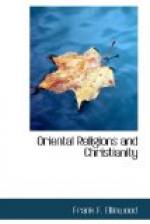The Greek traditions of a flood varied according to the different branches of the Greek nation. The Arcadians traced their origin to Dardanus, who was preserved from the great flood in a skin-covered boat. The Pelasgians held the tradition of Deucalion and his wife, who were saved in a ship which was grounded on the summit of Pindus. As the water receded they sent out a dove to search for land. The Assyrian account, which was found a few years ago on a tablet in the palace of Assur-bani-pal, claims to have been related as a matter of personal experience by Sisit, the Chaldean Noah, who was commanded to construct a ship 600 cubits long, into which he should enter with his family and his goods. At the time appointed the earth became a waste. The very gods in heaven fled from the fury of the tempest and “huddled down in their refuge like affrighted dogs.” The race of men was swept away. On the seventh day Sisit opened a window and saw that the rain was stayed, but the water was covered with floating corpses; all men had become as clay. The ship rested on a mountain top, and Sisit sent forth a dove, a swallow, and a raven. The dove and the swallow returned, but the raven was satisfied with the floating carcasses. Sisit went forth and offered sacrifice, around which “the gods hovered like flies.”
Professor Rawlinson thinks that these accounts and those given in Genesis were both derived from the earlier traditions, the Assyrian version having been greatly corrupted. The Chaldean tradition is slightly different. The Noah of the Chaldeans was commanded in a dream not only to build a ship, but to bury all important documents and so preserve the antediluvian history. As the flood subsided he, his family, and his pilot were transferred to heaven, but certain friends who were saved with them remained and peopled the earth. Among the ancient Peruvians we find a tradition of a great deluge which swept the earth. After it had passed, the aged man Wiracotscha rose out of Lake Titicaca and his three sons issued from a cave and peopled the earth.[178] Hugh Miller and others have named many similar traditions.




